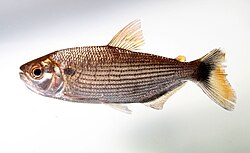| Brycon Temporal range: | |
|---|---|
 | |
| Brycon hilarii | |
| Scientific classification | |
| Kingdom: | Animalia |
| Phylum: | Chordata |
| Class: | Actinopterygii |
| Order: | Characiformes |
| Family: | Bryconidae |
| Subfamily: | Bryconinae |
| Genus: | Brycon J. P. Müller & Troschel, 1844 [1] |
| Type species | |
| Brycon falcatus J. P. Müller & Troschel, 1844 [1] | |
| Synonyms [1] | |
| |
Brycon is a genus of freshwater ray-finned fishes belonging to the family Bryconidae, and order Characiformes. The fishes in this genus are found in Central and South America, ranging from southern Mexico to northern Argentina. [2] Despite not being closely related to true trout, they are sometimes called South American trout. [3] Members of the genus may be referred to by a number of other different common names in various languages. They reach a maximum length of 11.9–79.5 cm (4.7–31.3 in), depending on the species involved. [2] Some species perform seasonal breeding migrations. [4]
Contents
They feed heavily on fruits and seeds, but also take other plant material, invertebrates, and small fish. [5] [6] Their food is typically taken from the water, but they are able to jump out of the water to "pluck" low-hanging seeds and fruits directly from trees. [3] Some seeds are crushed when eaten, but may also pass undamaged through the fish, making them seed dispersers. [3] [5] [6]
Brycon support important fisheries, and, based on a review by IBAMA, they are the fifth most caught fish by weight in the Brazilian Amazon. [4]
One fossil member of this genus is known in † Brycon avus (Woodward, 1898) from the Oligocene-aged Tremembé Formation of Brazil. [7] [8] A slightly older potential specimen of B. avus is also known from the Late Eocene/Early Oligocene of the Aiuruoca Basin. [9]




